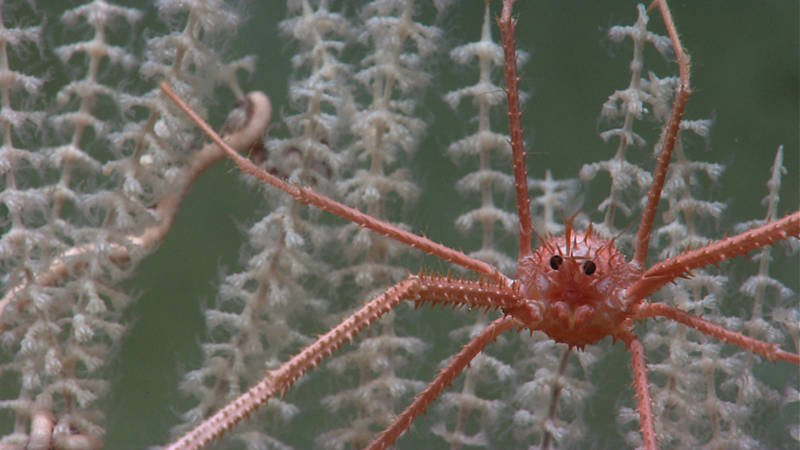
A squat lobster resides on a deep-sea octocoral. Image courtesy of NOAA Okeanos Explorer Program, Gulf of Mexico 2014 Expedition. Download larger version (jpg, 1.2 MB).

A squat lobster resides on a deep-sea octocoral. Image courtesy of NOAA Okeanos Explorer Program, Gulf of Mexico 2014 Expedition. Download larger version (jpg, 1.2 MB).
Okeanos Explorer EX1402L3
Dive 03: Assessing Mid-water Coral Habitats. Video courtesy of NOAA Office of Ocean Exploration and Research. Download (mp4, 34.5 MB)
The third dive concentrated on assessing mid-water coral habitats by examining first the ~ 30-degree slope then part of the crest of an approximately 100-meter high topographic high (part of a sinuous ridge) in depths of ~1,150-1,050 meters. This dive represented the first of multiple dives designed to quantify models of deep-water coral habitats in the Gulf of Mexico. The dive began on flat sedimented seafloor at ~1,152 meters. Most of the dive involved moving slowly up a steep slope featuring scattered carbonate hardground outcrops of varying size. Many of the larger outcrops were encrusted with solitary corals and associates. Generally disarticulated bivalve shells were ubiquitous, suggesting the proximity of chemosynthetic communities. Some of the hardgrounds were also composed of cemented bivalve shells. Occasional concentrations of live mussels and clams and bacterial mats were encountered, but escaping bubbles were observed only once. The steepness of the slope led to substantial visual evidence of downslope movement of sediment, evidenced by slide scars. In several instances, light colored outcrops were exposed in these scars that looked like hydrate, but that could not be confirmed. Corals attached to hardground outcrops became more common at the edge of and across the crest of the topographic high at ~1,052 meters. The top of the high was generally characterized by a pronounced hummocky topography; some of the depressions were several meters deep. Such topography is suggestive of collapse, the result of dissolution of upwardly mobile evaporites at the seafloor. The dive ended about an hour early as a result of failure of the bow thruster, due to overheating associated with seaweed clogging the thruster well.